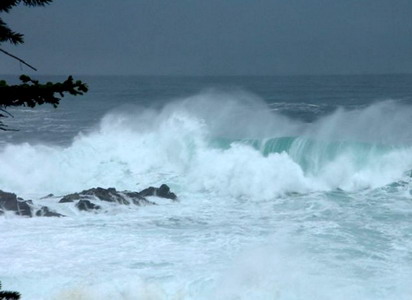Oddly enough, the vast majority of “winter” storms occur in the “winter.” They occur in cold places, when the amount of thermal energy is at a minimum. They occur when a mass of cold air sweeps through and wedges under warmer, humid air.
The biggest waves in California occur during the winter.
Yet we constantly hear the nonsensical claim that “global warming causes more storms, because there is more energy in the system.”
If you believe that, then next time you want to escape the stormy weather of Hawaii, I suggest a vacation in Antarctica. Thermal energy is very low there, so they must not have many storms. Greenland and other Arctic locations should also be suitable.
Below is a good web page where people talk about the “calm” weather they have encountered in polar regions with very low thermal energy.
http://www.explorersweb.com/polar/
New York has been hit by a number of strong storms this week. A couple of them delayed the US Open Final. Another one struck last night. Not coincidentally, the northeast has seen many record cold temperatures this week.
http://mapcenter.hamweather.com/records/7day/usnortheast.html?c=all
Energy flows across gradients. Batteries have a positive and a negative terminal. A battery with two +1,000 volt terminals would be useless. No electricity would flow between them.
Wind blows between areas of high energy and low energy. Between high pressure and low pressure.
A rock falls off a cliff because of the difference in potential energy between the top and the bottom. A rock sitting in the middle of a high plateau can not fall, despite its high potential energy.
Similarly, storms require both warm and cold. They require both high pressure and low pressure.
If the Arctic warms, we should expect to see fewer storms, not more storms. Like on hot, hot Venus – where they have essentially no storms.





I assume that for your first sentence you meant to write, “…majority of storms occur in the winter.”
No, that is what I intended to write. I didn’t want the thread to get distracted by a summer vs. winter argument.
Heh I just said this a few days ago in the tornado thread… well I said it with much fewer words and much less technical info… but… well… u have to have cold and warm for storms 😛
Calm weather? They haven’t seen a windstorm at Thule! I remember one day in January when it was warmer at Thule than at Miami Beach. Only problem was that the wind was blowing 150 mph at the time. There are down-slope winds there that must be experienced to be believed.
So if you were to expect larger storms you would need to see larger gradients in heat distributions: Warmer summers/colder winters or larger gradients tropics to polar. If the poles warm faster than the tropics you should see the opposite affect. Something seems to be missing in the CAGW logic.
One thing I would think might actually cause more violent storms would be clearer air: larger heat swings night to day and seasonally. Radiational cooling would be high at the poles in the winter, but radiational heating would still be relatively high in the tropics so you get a larger gradient.